The old galactic empire fell along time ago and its knowledge was lost with it. However, a few planets have discovered portals for interstellar travel. As the inhabitants of these long separated planets meet up and explore more worlds, they try to assemble into some body that will not repeat the mistakes of the old empire. The New Galactic Senate is formed on the only planet with all three portals and thus called the Hub. Now as a politician from your home world, you must explore new planets, find ancient specialists who have been held in chrono-stasis since the days of the empire, and exert your influence across the galaxy until you can become the Senate President. This time of renewal and rebirth is truly a Galactic Renaissance.
What Is Galactic Renaissance?
Galactic Renaissance is a political card game of space exploration and influence for 2-4 players, ages 14 and up, and takes about 75 minutes to play. It’s currently seeking funding on Kickstarter, with a pledge level of $81 for a copy of the game. The campaign ends on April 11, 2023.
Galactic Renaissance was designed by Christian Martinez and published by Matagot, with illustrations by Tano Bonfanti. Is is the second game in the ‘political trilogy’ by Martinez which began with Inis.
New to Kickstarter? Check out our crowdfunding primer.
Galactic Renaissance Components
Note: My review is based on a prototype copy, so it is subject to change and may not reflect final component quality.
- 48 Emissary minis
- 4 Player boards
- 4 Player Stability tiles
- 28 Core Team cards
- 20 Institute minis
- 4 VP marker
- 28 Specialist cards
- 16 Objective cards
- 5 Starting Emissaries cards
- 15 Planet tiles
- 15 Planet tokens
- 5 Foundation minis
- 36 Portal tokens (12 red, 12 yellow, 12 blue)
- 20 Stability tiles (4 each of Stability 5 to 9)
- 1 New Galactic Senate board
- 6 Disorder markers
- 1 Portal selector marker

The planet tiles represent planets which can be inhabited by players’ elements. When a planet is explored and brought into play, a stability tile is also drawn and connected to the planet tile. Each stability tile has from 5 to 9 spaces on which elements can be placed. Portal tokens can be placed on the planet tile to represent how the planet is connected to other planets in the game.
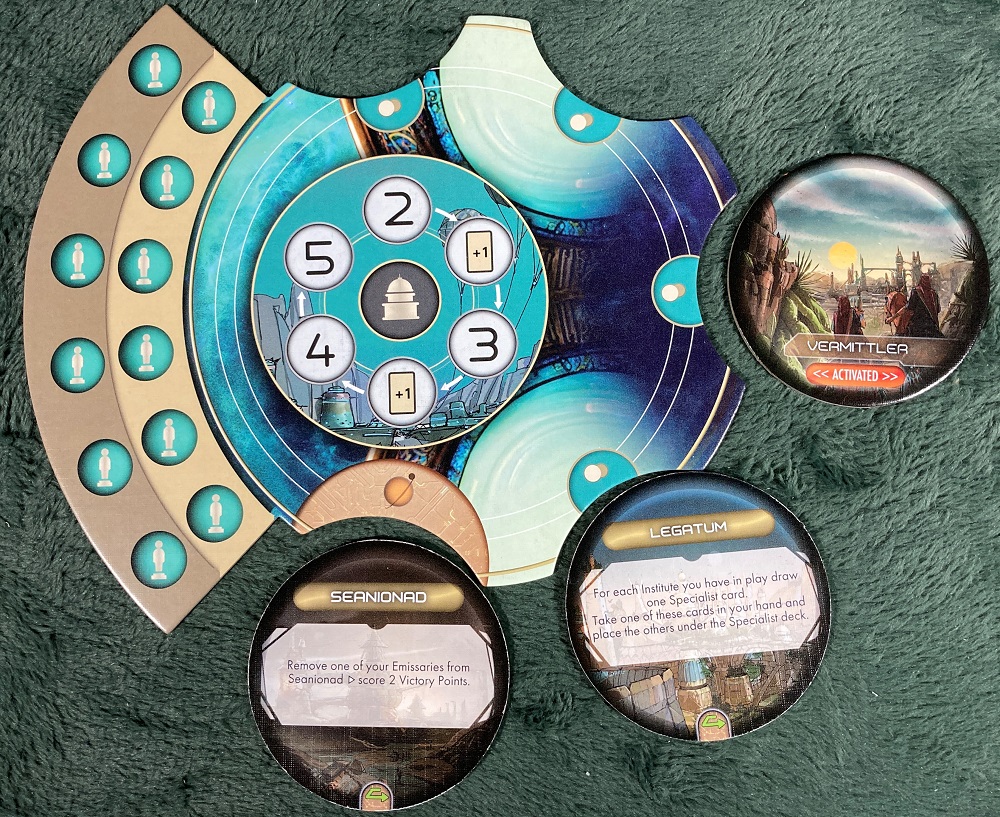
Each player gets a player board in their own color. The reserve of emissaries are placed in the spaces on the left side while institutes are placed on the spaces in the center. As you move institutes to planets, the vacated spaces allow players to draw an extra card or increase their hand size. Planet tokens are positioned in the indentations around the edge of the player board with room for the player’s home planet and up to four allied planets. Planet tokens have abilities on them which can be activated by certain cards.
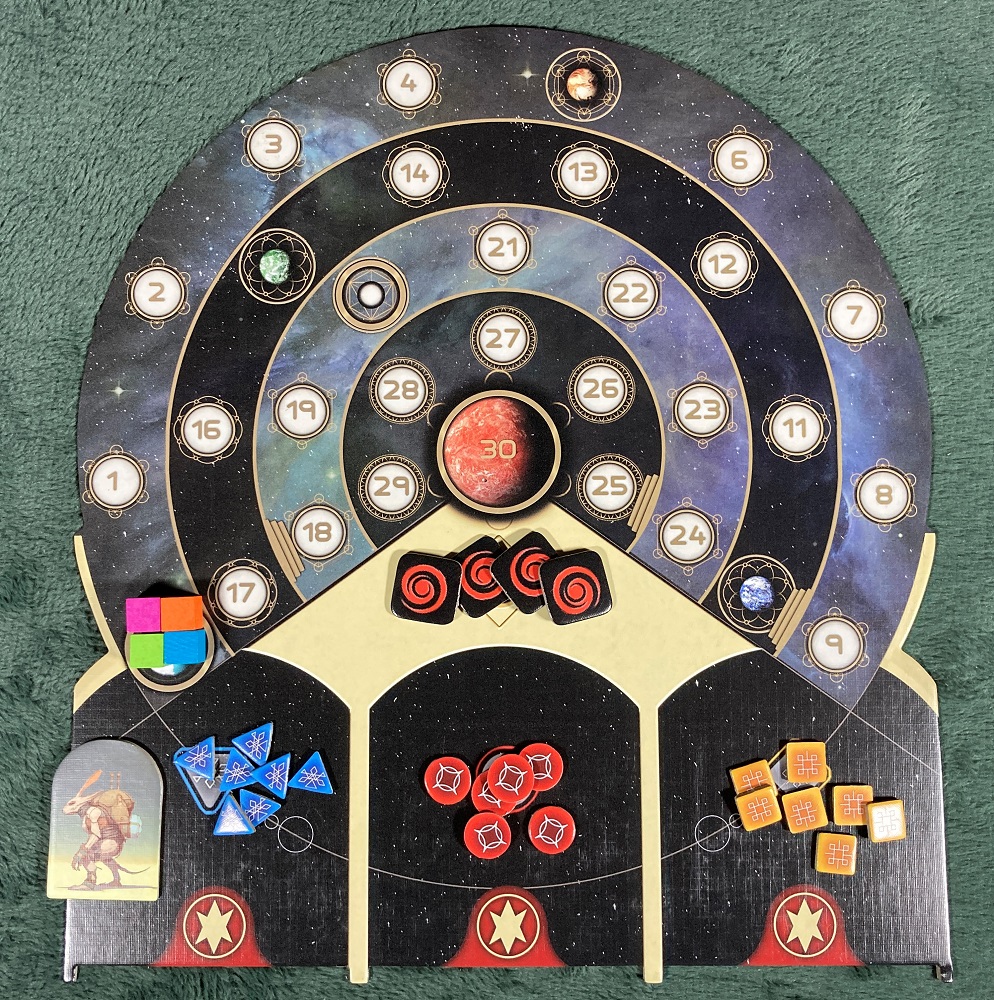
The New Galactic Senate board is used to keep track of players’ victory points as well as holds portal tokens and disorder tokens. The portal selector marker, referred to as the Cosmic Rabbit, moves across the portal spaces to indicate portals added to explored new planets. There are spaces at the bottom of the board for the objective cards.
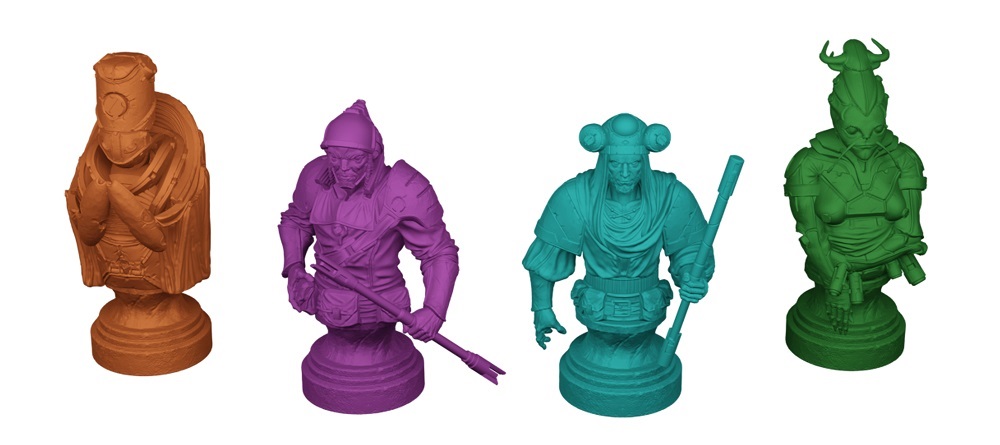
There are three different types of elements in the game. Emissaries are agents sent by players to increase influence on planets. Institutes can be placed on planets to also help increase influence and can be used to recruit new emissaries on those planets. Building institutes also opens up spaces on players’ boards so they can increase the number of cards in their hand. Foundations are not controlled by players though they can be placed on planets. These structures allow players to gain specialist cards which are added to their decks of cards.
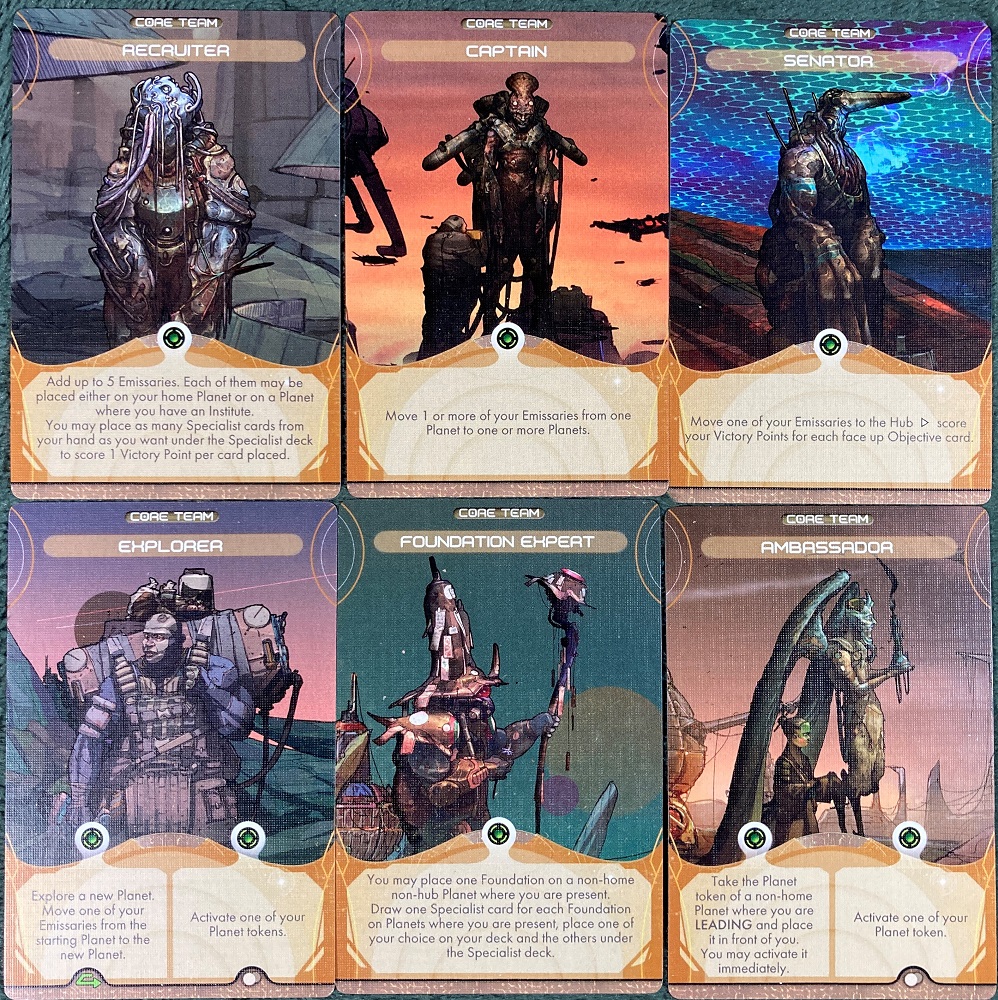
Every player gets the same seven core cards in their team’s color. These cards provide actions which the players can take during their turns. Explorers allow you to explore a new planet or activate one of your planet tokens. Foundation Experts let you place a foundation and then draw a specialist card. The Institute Director lets you place an institute on a planet in exchange for removing emissaries. The Recruiter lets you add emissaries from your reserve to your home planet or a planet where you have an institute. The Captain lets you move emissaries from one planet to one or more planets. The Ambassador is used to take a planet token of a planet where you are leading and place it on your player board. It also allows you to activate one of your planet tokens. Finally the Senator moves one of your emissaries to the hub and then scores victory points based on the objective cards.
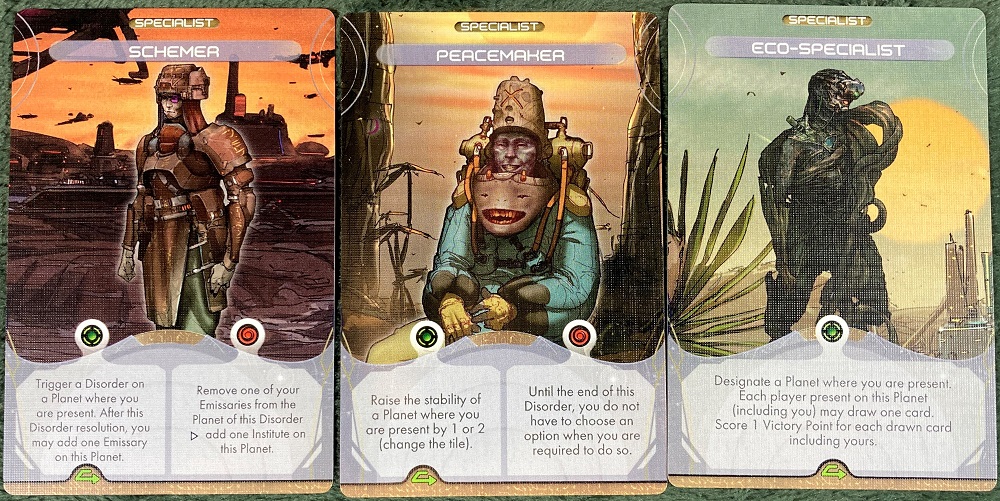
The 31 specialist cards are all unique and provide additional types of actions which can be taken during a player’s turn. Some are quite powerful and some allow you to play another action once you have played that specialist card. Specialist cards are obtained using the Foundation Experts.
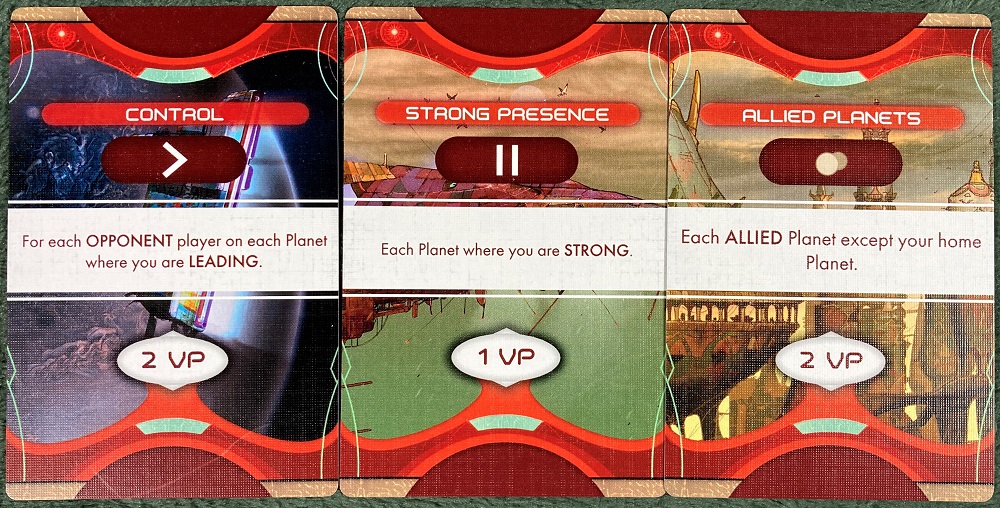
Though there are 16 different objective cards, only five are used during a single game and then only two or three are active at any one time. When playing a Senator card, a player then scores victory points based on meeting the various objectives on the active cards.
How to Play Galactic Renaissance
You can download a copy of the rulebook here.
The Goal
The goal of the game is to be the first to score a total of 30 victory points and score 10 victory points in one turn.
Setup
Start off by shuffling the planet tiles and specialist cards into face down piles. If playing with less then four players, you will remove some of the stability tiles and then shuffle the remaining into another facedown pile. Place the planet tiles into a pile in any order and then put the foundation minis, disorder markers, and diplomat markers within easy reach of all players. Now each player takes 12 emissaries, 1 player board, 1 stability player tile, a deck of seven core team cards, 5 institutes, and one VP marker all in the same color.
Place the New Galactic Senate board off to one side. Shuffle the objective cards and place one face down in the objective slots on the board. Then place one objective card face up on top of the first and second face down objective cards. Return the remaining objective cards to the box. Players place their VP markers in the starting space of the VP track. Next place the portal tokens in their matching spaces on the board and the Cosmic Rabbit portal selector marker on the blue portal token space.
Players now will select their starting assets. Place a number of planet tiles and their planet tokens face up equal to the number of players plus one. Place that same number of special cards face up and then the starting emissary cards as directed by the rules depending on the number of players. Randomly select a first player. Then starting with the player to their right and moving counter-clockwise, each player selects one of the assets of the type they have not already taken until each player has one of each in front of them. The extra specialist card is placed face down at the bottom of the pile of specialist cards. Players place their home planet they selected in the player area in front of them and attach their color of stability tile to the planet tile. They take the number of emissaries from their player board equal to the starting emissary card and place them on the stability tile of their home planet. Players then attach their home planet token to the space at the bottom of their player board. Finally they shuffle their chosen specialist card into their deck of core team cards and place it face down.
The planet token that was not chosen is the Hub. Draw stability tiles until one with seven or more spaces is chosen and attach it to the planet tile. Place the Hub planet token on the planet tile and then place one of each of the three portal tokens on the planet tile as well. The Hub is the only planet that will have all three portals on it. Starting with the first player, each takes a portal token from the type where the Cosmic Rabbit is located and then moves this marker to the next portal space. The portal marker is placed on their home planet tile so each home planet has one portal. Finally players draw three cards from their deck to form their hand. For only one time, they may choose to place one or more of the cards in their hand face down under the bottom of the deck in any order and draw that many cards into their hand. You are now ready to start the game.
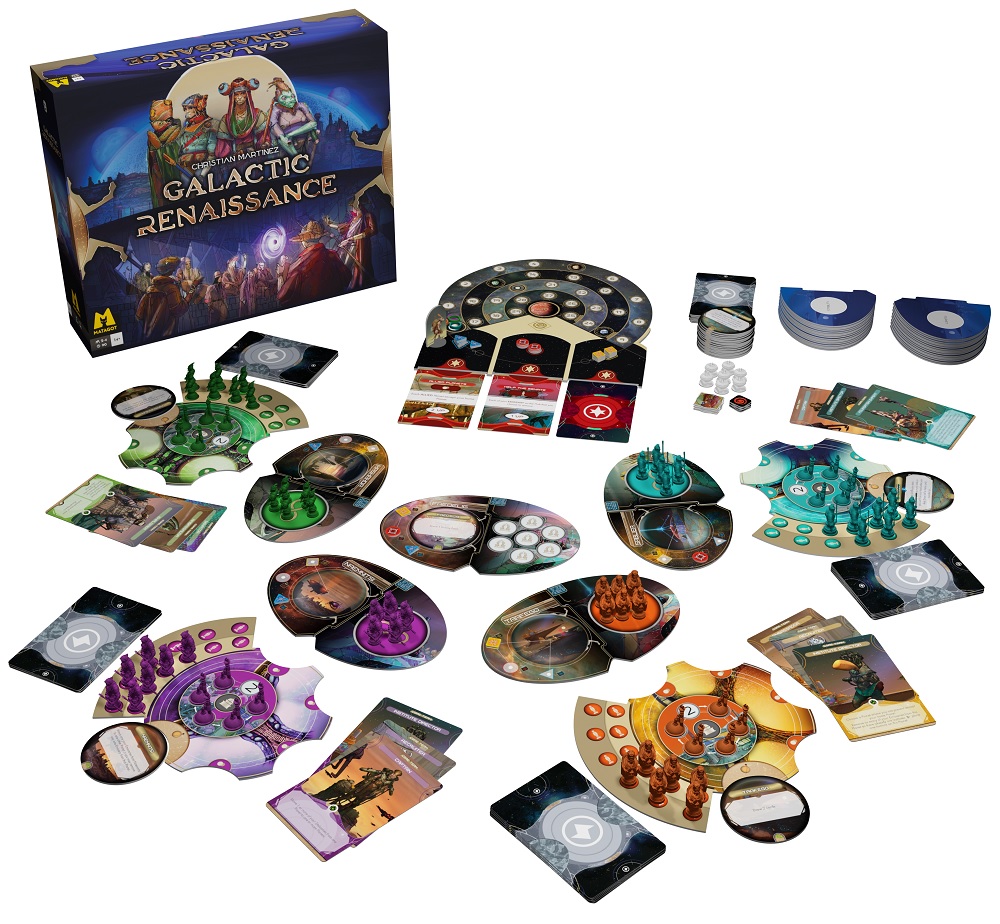
Gameplay
Galactic Renaissance is played in turns with each player going through five steps before the next player takes their turn. The first step is for the player to play an operation card. To do this, a player plays a card from their hand and places it face up in front of them. Operations on a card are designated by a green symbol above them. If a card has two different operations on it, the player may choose one of the operations to resolve. Some cards have a play again symbol underneath an operation. A player may play another card from their hand. This can continue until they play a card without the play again symbol. Played cards are kept face up in a pile in the order they were played until later in the turn. A specialist card may also be played at no cost to draw another card from the deck. In this case, the operations on the specialist card are not used.
There are several different types of actions players can take using their cards. When they move emissaries, from one planet to another, they can only move to a planet that has the same color portal as the planet from which they are moving. When a player activates a planet token attached to their player board, they resolve the ability on the token and then turn it over to its activated side since it can only be activated once per turn. If a player chooses to explore a new planet, they first determine a planet with one of their emissaries they will use to explore and select a portal color from that planet’s portals. they then draw a planet tile and place a portal token of the chosen color on it. They then take a portal token from the space where the Cosmic Rabbit is located (if it is a different color) and move the Cosmic Rabbit to the next portal space. Then draw a stability tile and attach it to the planet tile. If there is a planet on which the majority of the elements are yours, you can play the Ambassador card and take the plant token for that planet, even if it is attached to the board of another player, and attach it to your player board. This planet is then considered an allied planet. If you already have five planets attached to your board, then you must take one of your allied planet tokens and place it back on its planet tile.
The second step is to resolve disorders. If during the player’s turn, there are more elements on a planet than spots on its stability tile, that planet is now in disorder and a disorder token is placed in the notch at the bottom of the planet tile with the red side up. There can be more than one planet in disorder depending on the player’s actions. Disorder is only checked during this step, not during the first step. For each planet in disorder, a disorder resolution round must take place. Starting with the active player and then going clockwise, each player with an element on the planet in disorder must choose and resolve one of four options. They can remove one of their emissaries from that planet and return it to their reserve on their player board. Or they can move two or more of their emissaries on that planet to one or more allied planets. Or they can remove one of their institutes from the planet. Or they can play a disorder card from their hand. Some specialist cards have a disorder action represented by a red symbol. If after a full round of each player taking a turn, the planet no longer exceeds its stability threshold, the disorder is resolved for that planet. The actions of the players during this resolution may cause other planets to go into disorder. Then the active player chooses the next planet in need of resolution. It is important to note that once a disorder has been resolved, flip the disorder marker over. No elements may be moved to planets with the resolved marker for the rest of the turn. Remove all disorder tokens at the end of this step.
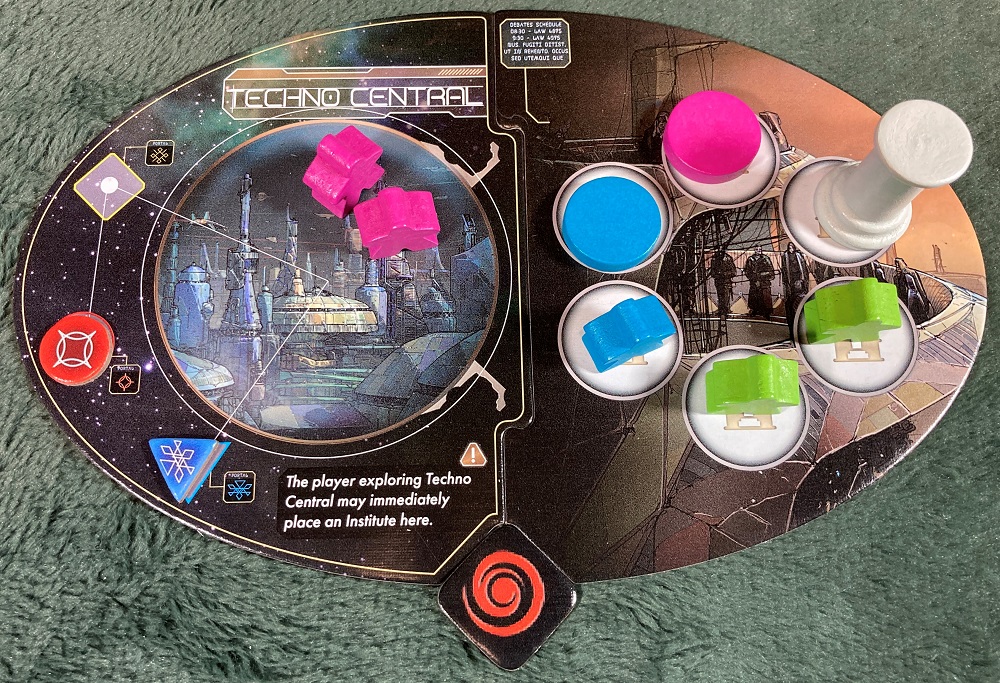
After all disorders have been resolved, during the third step the active player discards their played cards to the bottom of their deck in the order played. For the fourth step, the player may discard one card from their hand to the bottom of their deck. Finally, for the fifth and final step, the player may draw cards from the top of their deck until their hand is at their current hand limit. It is now the next players turn.
Victory points can be scored in a few different ways. Some cards award victory points as part of their operations. When you play the Senator card, you move one of your emissaries to the hub and then score victory points using all of the face up objective cards. Once a player reaches the 5 space on the track, flip the third objective card face up. When the 10 space is reached, flip over the first stack of objective cards to reveal the card on the bottom. After the 15 space is reached, flip over the second stack. There can only be up to three active objective cards at a time.
Game End
The game ends when a player reaches 30 victory points on the New Galactic Senate board and scores 10 points during that turn. If on a turn you move your VP token to the 30 spot, but did not score 10 points that turn, then leave your token on the 30 spot. Now you only need to score 10 points within a single turn to win the game.
Why You Should Play Galactic Renaissance
Upon first looking at the rules, Galactic Renaissance can seem complex. However, once you understand a few of the main concepts, it is pretty easy to play. In fact, setting up the game is probably the toughest part of the game and it is not difficult once you have learned all of the components. Since none of the core team cards have a play again symbol, except for the Explorer when you use it to explore a new planet, at the start of the game, you will usually only be able to play one card per turn. As you gain more specialists and have a larger hand size, then you are more likely to be able to play multiple cards. Also planets usually do not go into disorder for a few turns so you can get the hang of the gameplay before you have to start a disorder resolution. As the game progresses and players have more elements in play, disorders become more prevalent and the resolution phase can often cause additional planets to go into disorder in a chain reaction. Therefore, while the game starts off slow, it quickly ramps up over time. This allows new players to learn portions of the rules at a time as they come up and not have to know everything right from the beginning. For example, you don’t need to learn the disorder resolution steps until that comes up during the game.
While I like the pace of the game, in my opinion, the cards are the stars of the game. Every player has the same core team cards with the basic actions you need to play the game. However, since each specialist is different, as you add specialists to your deck, they can affect your strategy for winning the game. In fact, your strategy can change on the fly as you gain new specialists. This mechanic gives Galactic Renaissance a feel of a deck-builder game, though you build your deck slower than most games of that genre. Another factor that keeps players on their toes is the way objective cards are revealed and can change during the game. You may be working towards the first objective card; however, if someone reaches the 10 space on the victory point track, that card is replaced by the card underneath it. This can quickly force you to change your strategy. Then once you get to 20 VP or more, then you really need to plan to get 10 points in a single turn to win the game.
I was able to play with a prototype copy of the game. The emissaries, institutes, and foundation miniatures were represented by meeples and other pieces. However, in the final version of the game, they will be sculpted miniatures. Other than those changes, everything else in the prototype should be similar to the final product. The quality of the components was great and I was impressed by the number of planets, specialist cards, and objective cards. You only use five objective cards in a game, and even with four players, you are unlikely to use all of the planets and specialist cards, so there is a lot of replayability in the game. In fact, when I finished one game, I wanted to play again to see what new strategies I could come up with to win.
After having played through a few games, I am impressed and enjoy playing Galactic Renaissance. While it has some familiar game mechanics, the way they are combined provides for some unique and intriguing gameplay. I really like games that use cards and in Galactic Renaissance playing your cards right is how you win. However, while playing cards, you also have to pay attention to the current objectives and work towards them. Some reward you for your allied planets while others focus on having more or even fewer elements on planets. This keeps players focused and constantly revising their strategies. What worked to win one game may not work during another game. If you enjoy games with card based play and area control that will keep you engaged right up until the end, then I recommend Galactic Renaissance as a great addition to you game collection.
For more information or to make a pledge, visit the Galactic Renaissance Kickstarter page!
Click here to see all our tabletop game reviews.
![]() To subscribe to GeekDad’s tabletop gaming coverage, please copy this link and add it to your RSS reader.
To subscribe to GeekDad’s tabletop gaming coverage, please copy this link and add it to your RSS reader.
Disclosure: GeekDad received a copy of this game for review purposes.





